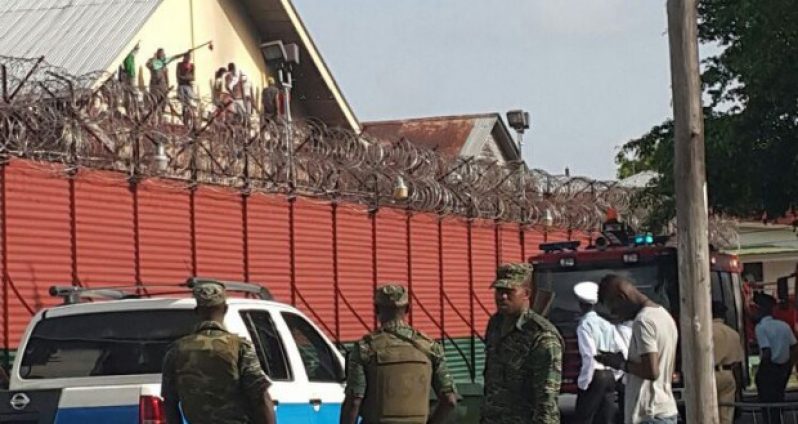By Shauna Jemmott
ANDREW Holder, the Guyana Fire Service station officer who testified before the prison riot Commission of Inquiry on Friday, said that in conducting investigations, a prisoner related how he used a plyboard to shield himself and others trapped in the fire, saving them from being burnt.
According to Holder, the inmate recounted the ordeal shortly after the fire on March 3 at the Camp Street penitentiary and related that while being entrapped in the heat with their lives at risk, he spotted the plyboard under a bed and used it to block the fire which had blazed through the front of the dormitory and was drawing close to the other part of the room.
He made the revelation under sworn testimony before the three-man Commission, headed by retired Justice James Patterson, and including Human Rights activist Merle Mendonca and former Director of Prisons Dale Erskine.
According to Holder, the prisoner told him just before the fire blazed out of control, he saw tear gas canisters being thrown into the jail and his eyes and skin began burning. He heard an instruction from another inmate to “lie low, get water and wet ya’ll face… is just tear gas”, before he saw thick smoke and ran to a side door for air.
BEDS ON FIRE
Holder said the prisoner told him that about 10 others joined him in “lying low” by the northern door to the burning dormitory and some 25 minutes after, he noticed all the beds were on fire.
It was then that another inmate shouted, “look the fire coming to we” and another advised that they “push the beds away.”
According to the fireman, the prisoner said that while pushing the beds he found a piece of plywood under a bed and used it to shield himself and others from the fire consuming them.
It was then that he heard a prisoner on the catwalk calling their names and a prison officer attempted to open the door twice – once with keys and another with a sledge hammer.
Earlier in his evidence, Holder told the Commission that when he arrived at the Camp Street prison on March 3 around 11:30 to 12:00hrs, his role was first “to assist my fellow firefighters in whatever way possible.”
While he observed that firefighters within a short time had the situation under control, he waited until the fire in the Capital A block was fully extinguished before commencing his investigations.
WAR ZONE
He said on arrival in the jail yard, he observed the climate was “very chaotic… likened to a war zone”, and “based on the explicit anger vented by prisoners as “we entered the prison yard,” the firefighters’ work was affected.
“It would have had a mental toll on firefighters’ response,” he said, as many of the firefighters were never trained for, nor experienced such a situation.
During firefighting operations, “I did not see prisoner or prisoners becoming violent with firefighters… most of them were secured within their various cells or blocks…”
Holder said the only prisoners in contact with firefighters were those who broke out of Capital A, “helping to drag prisoners to the catwalk or helping to move some equipment.”
In his investigation which commenced around 12:31hrs, he entered the building and observed the fire pattern, level of destruction and the level of exposure to varying degrees of heat.
“I am trained to enter the building and use my knowledge to observe fire patterns and the level of destruction within that structure, level of exposure to varying degrees of heat and to make mental analysis to what transpired.”
He explained that when hot air rises in an enclosed building, smoke and flames go straight up to the ceiling and after a while begin to circle the entire area. He said the smoke and heat in the ceiling eventually depletes the oxygen from the room, especially in an enclosed environment such as the Capital A block, which was the centre of the fire, which claimed the lives of 17 prisoners.
FLASHOVER
“As heat begins to grow in intensity, it gives rise to a phenomena called “flashover” which automatically takes the fire into the stage or the realm of a fully developed fire. When the room reaches a temperature of 500 to 600 degrees Celsius, flashover occurs and automatically takes it into a fully developed fire.”
The officer explained that this is a stage in which items even 20 to 25 feet away from the point of the fire automatically catches afire.
“Everything in that room would automatically ignite – bed, clothing, timber, even human beings,” but at different auto-ignition temperatures, and while mattress and clothing ignite almost immediately, timber may take a little longer.
“After flashover, the fire continues to burn violently or rapidly until all fuel is consumed,” and when there is nothing left to burn, the fire automatically goes out, unless it would have been put out manually,” he explained.
He called the stage of a ‘flashover’ an “unusual” situation, one which two in every 100 firefighters around the world have ever witnessed in their entire firefighting careers, as they either arrive on the scene before or after this stage.
Flashovers are very technical and the factors contributing include dimension of the room, materials in the room, flammability range or ratio and the restriction or availability of oxygen. Holder said he was not sure how long the prison dormitory fire took before it was developed into a flashover.
In Capital A, “it would obviously accelerate a flashover,” mainly because of the material present within the facility at the time of the fire.
He said the flashover occurred long before the Guyana Fire Service arrived on the scene and when he arrived, “I could hear banging on the metal door … persons screaming to get out.” He also saw smoke emanating from the building, which “indicated [that] this is not an incipient fire, neither is this a fire that is about to decay, because there were still persons alive in the building.”
The primary material being mattresses giving off carbon monoxide and hydrogen cyanide, which would have had the effect of suffocation, dizziness and persons being unable to breathe, and after being exposed to it for some amount of time, one could become unconscious, Holder explained before the CoI.



.jpg)








